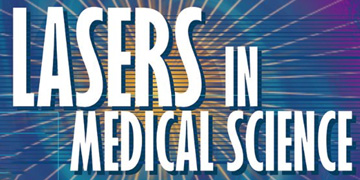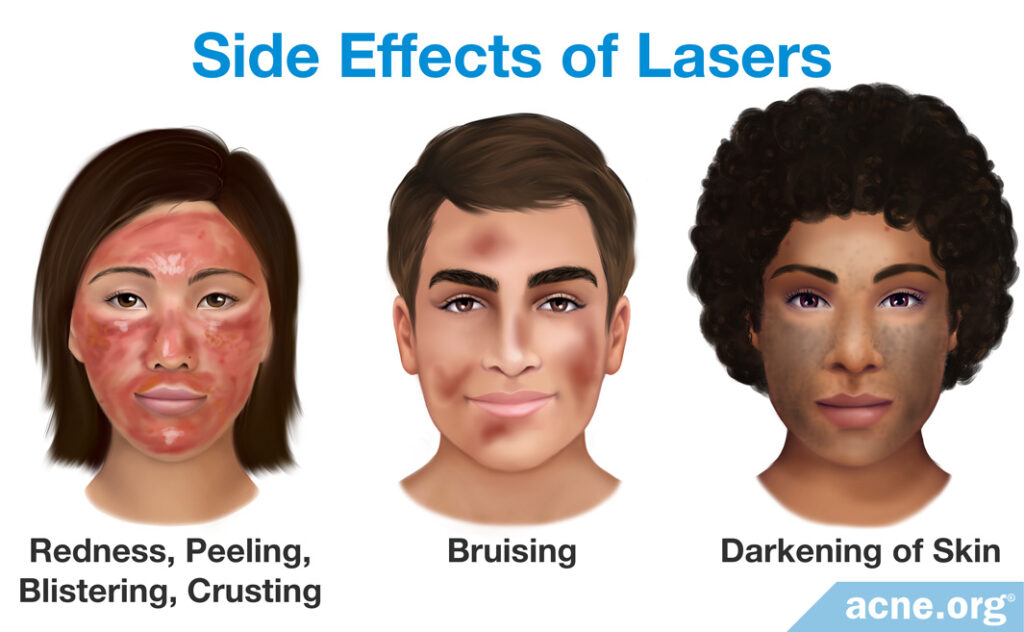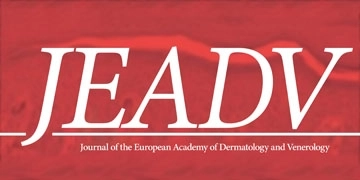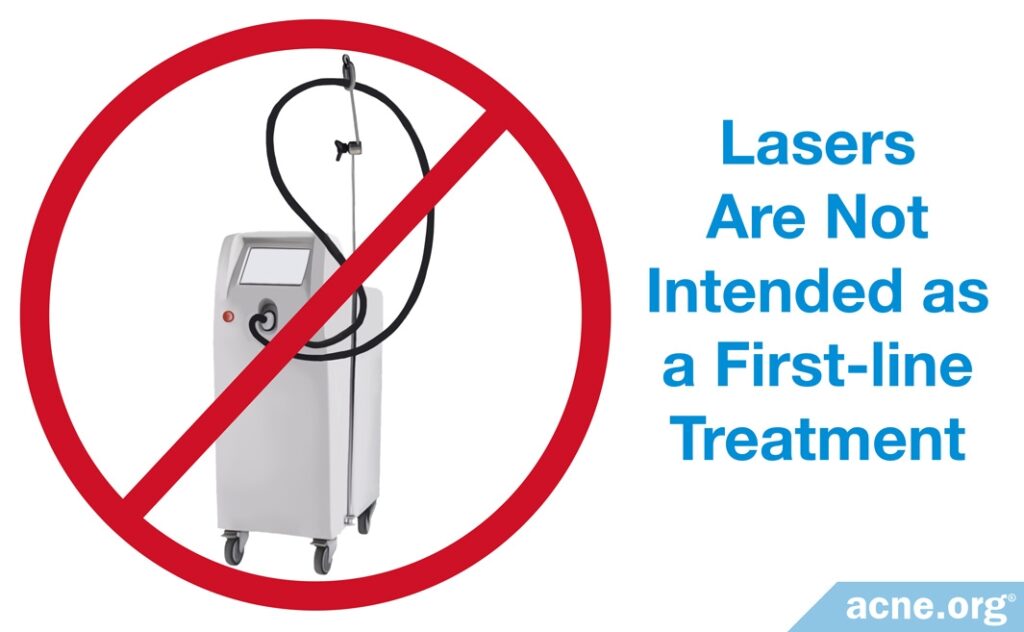Laser Therapy Is Not a First-Line Treatment, but Is Still a Tool in the Toolbox

The Essential Info
What Is It? Laser treatment for acne normally involves about three sessions at a doctor’s office and normally costs between $600-$1500 total. While it does help reduce acne symptoms, it is likely to only provide partial relief.
How Does It Work? Laser therapy can reduce acne bacteria and skin oil, and may provide anti-inflammatory benefits as well.
How Well Does It Work? So far, studies have shown us a wide range of results, from 36-86% clearance of acne. However, overall, laser therapy provides only partial results and is not considered a first-line acne treatment.
Side Effects: Like many things in life, the stronger the laser, normally the better it will work, but also, the more side effects it will produce. These side effects can include redness, peeling, blistering, crusting, and bruising of the skin. Of particular concern is darkening of the skin in darker-skinned people as well, so if you have darker skin and decide to inquire about laser therapy, be certain to ask your dermatologist about this issue and do not undergo laser therapy until you are satisfied with the laser he/she has chosen. In recent years, fractional lasers, which are lasers that only pinpoint laser light in a dotted pattern have grown in favor for their ability to produce results while limiting side effects.
Long-term Concerns: Because laser therapy–particularly stronger lasers–may permanently damage skin oil glands, there is concern that this might cause unintended long-term consequences like premature aging. Any treatment that might permanently alter your skin should always be met with caution.

The Science
Lasers are an acne treatment option performed in a doctor’s office aimed at treating and preventing light-to-moderate acne, although it has shown some promise in the treatment of severe acne (cysts/nodules).1
Laser therapy tends to work better and have fewer side effects on lighter skin tones.
How it works: Lasers may work in the following 3 ways:
- Kills acne bacteria: Much like at-home light devices, lasers work primarily on the premise of exciting compounds that bacteria produce called porphyrins.2 When the laser light excites the porphyrins, this damages the bacterial wall, effectively killing the bacteria.3 Fewer acne bacteria should help reduce symptoms of acne.
- Reduces skin oil: Laser treatment may also reduce skin oil (sebum) levels. Generally speaking, less sebum = less acne.
- Reduces inflammation: Lasers may have anti-inflammatory properties. Since acne is at its root an inflammatory disease, reducing inflammation can help reduce acne as well.1
At least 3 treatments required: Laser treatment normally requires 3 treatments, about a month apart, at the doctor’s office. Doctors sometimes recommend more treatments and/or more frequent treatments, depending on the doctor’s opinion and the severity of acne.
Cost: Laser therapy for acne costs $200-$500 per treatment, or $600-$1500 total.
Types of Lasers
Various types of lasers are used for the treatment of acne. They are characterized based on the color and wavelength of light that they emit. There are 3 types:
- Pulsed-dye lasers (PDL)
- Potassium titanyl phosphate lasers (KTP)
- Infrared lasers
Most lasers used in the treatment of acne are called fractional lasers, for instance the Fraxel® laser. These lasers point light at very small columns of skin, like tiny polka dots, and therefore produce fewer side effects than lasers that shine light on the entire skin.
If you decide to try laser treatment, your doctor will recommend the right laser for you.
Expand to learn more about these lasers
All PDL lasers emit yellow 585-595 nm light, and all KTP lasers emit green 532 nm light. Infrared lasers come in different types, each of which emits a different colorless wavelength above 1000 nm. Infrared lasers include the 1450 nm diode (1450 nm), erbium:glass (1550 nm or 1540 nm) and Nd:YAG (1064 nm and 1320 nm) lasers.1
In the last few years, a new infrared “vacuum” laser called Isolaz® has also become available.4-6 This laser uses a vacuum to isolate and “suck up” a small area of the skin on which laser light is then applied.5
There is also a kind of PDL laser, which uses not only light but also heat, called the pulsed light and heat laser.
Generally speaking, infrared lasers penetrate the skin more deeply than other lasers7, followed by PDL, and finally KTP, although the depth to which a laser can penetrate also depends on the darkness of the skin. Darker skin prevents the light from penetrating as far.7-8
Does It Work?
Several (imperfect) studies show lasers work to a moderate degree: Scientists have produced several studies attempting to gauge the effectiveness of lasers for acne. However, these studies are almost all small cohort (just a few people), sometimes lack split-face design (comparing one side of the face to the other), tend to lack long follow-up (so it is hard to tell if results last), rely on patient reports of acne severity (which is subjective), and often employ no controls (so there is nothing to compare results against). Regardless, almost all of the studies show at least some improvement in acne symptoms, with results ranging from 36% to 83% clearance.1,9-21 Results are incomplete, meaning lasers alone usually do not completely clear acne.9 Currently, we don’t know which type of laser works best.
Lasers can be used alongside other treatments: One study that compared the results of laser treatment in combination with salicylic acid treatment showed that using the laser treatment in addition to salicylic acid treatment resulted in a better improvement in acne than salicylic acid alone.15 This result suggests that laser treatment may be beneficial if used in combination with other treatments.15 Similarly, a team of researchers recently reviewed all the evidence available on lasers and acne and concluded that while somewhat effective, lasers are probably most useful for acne in combination with other treatments. The scientists wrote, “Laser therapies likely offer the greatest benefit to acne vulgaris patients when used in conjunction with medical therapy.”22
Lasers work better than other light therapy options: Doctors have various light therapy options available to their patients such as intense pulsed light (IPL) treatment, which uses flash lamps to generate high intensity light that is not as concentrated as laser light, as well as LED light treatment. Overall, the concentrated light used in laser treatment has been shown to be more effective in treating acne than other light therapy options, including IPL or LED.1 One exception may be photodynamic therapy (PDT), which involves first applying a topical photosensitizing agent and then shining light on the sensitized skin, and tends to produce better results than other light therapy options.

In 2020, the journal Lasers in Medical Science published a systematic review of 17 studies on the efficacy and safety of laser therapy for acne. In a systematic review, scientists critically examine all the studies available so far on a topic to come to an overall conclusion. The review authors concluded that laser therapy seems promising for treating acne in the short term and tends to produce minimal side effects. However, the scientists noted that few studies followed up with patients in the long term to see how well the results of laser therapy held up over time. Therefore, they wrote: “In conclusion, further research is needed with…a follow-up that covers a longer period of time.”23
Side Effects

Most of the side effects of laser therapy are transient and bearable, particularly when fractional lasers are used.
Some patients experience pain or discomfort during treatment. Patients report varying levels of redness after treatment, as well as some inflammation and skin peeling and sometimes blistering and/or crusting.1,24
The severity of these side effects varies based on the type of laser used. The deeper a laser penetrates the more severe the side effects tend to be. For example, infrared lasers 1450 diode can cause considerable pain that requires the use of a topical anesthetic.1 However, with the use of a topical anesthetic, pain is well tolerated.1,20 KTP and PDL lasers can cause bruising, which usually goes away within ten days. KTP and PDL lasers can also cause some temporary darkening of the skin, especially in people with darker skin who have exposed themselves to the sun prior to the procedure.20,25

A 2008 systematic review of the 19 available controlled studies on lasers and acne, published in The Journal of the European Academy of Dermatology and Venereology, concluded: ” …most of the studies were of suboptimal methodological quality…we conclude that [light] treatments with lasers…possess the potential to improve inflammatory acne on a short-term basis…[however] [light] treatments for acne today are not included among first-line treatments.”11
Long-term Concerns

Because lasers work partially by reducing skin oil production, on the plus side, this can mean results may last longer than topical treatments. However, anything that potentially affects the skin on a long-term basis should be met with concern. Skin oil is an important part of the health of our skin, and permanently damaging skin oil glands might lead to unintended consequences like premature aging of the skin, or other yet unknown problems down the road.
Bottom Line
At this time, laser therapy is not considered a “first line treatment,” meaning it is best to try other, more effective and reliable treatments first.
Caution: Since laser therapy may permanently damage skin oil glands, do not simply accept the recommendation from any doctor to undergo laser therapy. Instead, ask questions and understand other options first. Anything that potentially permanently alters the body should be met with caution.
References
- Nestor, M. S., Swenson, N. & Macri, A. Physical Modalities (Devices) in the Management of Acne. Dermatol. Clin. 34, 215 – 223 (2016). https://www.ncbi.nlm.nih.gov/pubmed/27015782
- Porphyrin (2009) https://www.britannica.com/science/porphyrin
- Hamilton, F. L. et al. Laser and other light therapies for the treatment of acne vulgaris: systematic review. Br. J. Dermatol. 160, 1273 – 1285 (2009). https://www.ncbi.nlm.nih.gov/pubmed/19239470
- Boixeda, P., Calvo, M. & Bagazgoitia, L. [Recent advances in laser therapy and other technologies]. Actas Dermosifiliogr. 99, 262 – 268 (2008). https://www.sciencedirect.com/science/article/pii/S157821900870249X
- Narurkar, V. A., Gold, M. & Shamban, A. T. Photopneumatic technology used in combination with profusion therapy for the treatment of acne. J. Clin. Aesthet. Dermatol. 6, 36 – 40 (2013). https://www.ncbi.nlm.nih.gov/pubmed/24062872
- Omi, T., Munavalli, G. S., Kawana, S. & Sato, S. Ultrastructural evidence for thermal injury to pilosebaceous units during the treatment of acne using photopneumatic (PPX) therapy. J. Cosmet. Laser Ther. 10, 7 – 11 (2008). https://www.ncbi.nlm.nih.gov/pubmed/18330792
- Lasers in Medicine (2016) https://www.laserandhealthacademy.com/en/public/lasers_medicine/
- Mustafa, F. H. & Jaafar, M. S. Comparison of wavelength-dependent penetration depths of lasers in different types of skin in photodynamic therapy. Ind. J. Phys. 87, 203 – 209 (2012). https://www.researchgate.net/publication/234720204_Comparison_of_wavelength-dependent_penetration_depths_of_lasers_in_different_types_of_skin_in_photodynamic_therapy
- Elman, M. & Lask, G. The role of pulsed light and heat energy (LHE) in acne clearance. J. Cosmet. Laser Ther. 6, 91 – 95 (2004). https://www.ncbi.nlm.nih.gov/pubmed/15203999
- Faghihi, G., Isfahani, A. K., Hosseini, S. M. & Radan, M. R. Efficacy of intense pulsed light combined with topical erythromycin solution 2% versus topical erythromycin solution 2% alone in the treatment of persistent facial erythematous acne macules. Adv. Biomed. Res. 1, 70 (2012). https://www.ncbi.nlm.nih.gov/pmc/articles/PMC3544102/
- Haedersdal, M., Togsverd-Bo, K. & Wulf, H. C. Evidence-based review of lasers, light sources and photodynamic therapy in the treatment of acne vulgaris. J. Eur. Acad. Dermatol. Venereol. 22, 267 – 278 (2008). https://www.ncbi.nlm.nih.gov/pubmed/18221341
- Jung, J. Y. et al. Prospective randomized controlled clinical and histopathological study of acne vulgaris treated with dual mode of quasi-long pulse and Q-switched 1064-nm Nd:YAG laser assisted with a topically applied carbon suspension. J. Am. Acad. Dermatol. 66, 626 – 633 (2012). https://www.ncbi.nlm.nih.gov/pubmed/22033354
- Kim, B. J., Lee, H. G., Woo, S. M., Youn, J. I. & Suh, D. H. Pilot study on photodynamic therapy for acne using indocyanine green and diode laser. J. Dermatol. 36, 17 – 21 (2009). https://www.ncbi.nlm.nih.gov/pubmed/19207432
- Lee, E. J. et al. An open-label, split-face trial evaluating efficacy and safty of photopneumatic therapy for the treatment of acne. Ann. Dermatol. 24, 280 – 286 (2012). https://www.ncbi.nlm.nih.gov/pmc/articles/PMC3412236/
- Lekakh, O. et al. Treatment of Acne Vulgaris With Salicylic Acid Chemical Peel and Pulsed Dye Laser: A Split Face, Rater-Blinded, Randomized Controlled Trial. J. Lasers Med. Sci. 6, 167 – 170 (2015). https://www.ncbi.nlm.nih.gov/pubmed/26705462
- Prieto, V. G., Zhang, P. S. & Sadick, N. S. Evaluation of pulsed light and radiofrequency combined for the treatment of acne vulgaris with histologic analysis of facial skin biopsies. J. Cosmet. Laser Ther. 7, 63 – 68 (2005). https://www.ncbi.nlm.nih.gov/pubmed/16537210
- Ross, E. V. Optical treatments for acne. Dermatol. Ther. 18, 253 – 266 (2005). https://www.ncbi.nlm.nih.gov/pubmed/16229726
- Seaton, E. D. et al. Pulsed-dye laser treatment for inflammatory acne vulgaris: randomised controlled trial. Lancet 362, 1347 – 1352 (2003). https://www.ncbi.nlm.nih.gov/pubmed/14585635
- Tzung, T. Y., Wu, K. H. & Huang, M. L. Blue light phototherapy in the treatment of acne. Photodermatol. photoimmunol. Photomed. 20, 266-269 (2004). https://www.ncbi.nlm.nih.gov/pubmed/15379878
- Jih, M. H. & Kimyai-Asadi, A. Laser treatment of acne vulgaris. Semin. Plast. Surg. 21, 167 – 174 (2007). https://www.ncbi.nlm.nih.gov/pmc/articles/PMC2884837/
- Angel, S., Boineau, D., Dahan, S. & Mordon, S. Treatment of active acne with an Er:Glass (1.54 microm) laser: a 2-year follow-up study. J. Cosmet. Laser Ther. 8, 171 – 176 (2006). https://www.ncbi.nlm.nih.gov/pubmed/19839169
- Wiznia, L. E., Stevenson, M. L. & Nagler, A. R. Laser treatments of active acne. Lasers. Med. Sci. 32, 1647-1658 (2017). https://www.ncbi.nlm.nih.gov/pubmed/28776112
- Modena, D. A. O., Miranda, A. C. G., Grecco, C., Liebano, R. E., Cordeiro, R. C. T. & Guidi, R. M. Efficacy, safety, and guidelines of application of the fractional ablative laser erbium YAG 2940 nm and non-ablative laser erbium glass in rejuvenation, skin spots, and acne in different skin phototypes: a systematic review. Lasers Med. Sci. 35, 1877-1888 (2020). https://pubmed.ncbi.nlm.nih.gov/32472427/
- Babilas, P. et al. Experience with non-ablative fractional photothermolysis with a dual-mode laser device (1,440/1,320 nm): no considerable clinical effect on hypertrophic/acne scars and facial wrinkles. Lasers Med. Sci. 26, 473 – 479 (2011). https://www.ncbi.nlm.nih.gov/pubmed/21318344
- Hu, S., Atmakuri, M. & Rosenberg, J. Adverse events of nonablative lasers and energy-based therapies in subjects with Fitzpatrick skin phototypes IV to VI: A systematic review and meta-analysis. Aesthet. Surg. J. 42, 537-547 (2022). https://pubmed.ncbi.nlm.nih.gov/35019139/
The post Lasers and Acne appeared first on Acne.org.
